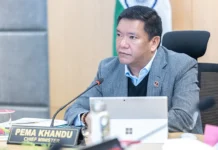ITANAGAR, 24 Dec: A stakeholders’ workshop under the project ‘Assessing the anthropogenic pressure on the critically endangered white-bellied heron (Ardea insignis), its habitat, and prey in eastern Arunachal Pradesh’, funded by the Anusandhan National Research Foundation, was held at MPen-II village in Changlang district on 21 December.
The workshop was organised by a research team from Coimbatore (TN)-based SACON, led by its principal investigator Dr Vidyadhar Atkore.
During the workshop, SACON Scientist C Dr Atkore presented an overview of the project, including its key findings.
He informed that the white-bellied heron has been listed as critically endangered on the IUCN Red list, and that its current global population is less than 50.
“The bird species is found only in eastern Arunachal Pradesh, Myanmar, and Bhutan,” he said.
“The research assessed its prey base, which is fish quantitatively as well as qualitatively to understand the status of its diversity, how has it been affected by anthropogenic threats, and its relations with the three ethnic communities, namely, Chakma, Lisu and Miju Mishmi, in the study landscape,” the organiser of the workshop said in a release.
Francis Anish, who is junior research biologist of the project, presented an overview on native and threatened fishes found in the rivers of Namdapha and Kamlang tiger reserves.
He said that local disturbances are being observed, especially outside the protected areas and a few sites inside the protected areas. “The disturbances include sand or boulder mining and unethical fishing practices, like electro-fishing and fishing with dynamite,” he said.
Anish explained the importance of sand, mud and boulders, especially during the breeding/spawning period as many riverine fishes require such river substrate to lay eggs and feed on aquatic insects, and how their removal has affected the fish population.
Namdapha National Park & Tiger Reserve Assistant Field Director Mito Rumi, Namdapha Wildlife Range RFO Biri Karba, Gandhigram Wildlife Range RFO Son Yowa Hade and field biologist Mayur H Variya also shared their views on the project.
Rumi opined that the efforts that have been made so far for the conservation of the white-bellied heron were not enough. He said that more attention needs to be drawn towards this bird.
Citing the example of projects like the ‘Great Indian Bustard’ to revive the population of the critically endangered Indian bustard, Rumi said that conservation of white-bellied herons should be done in the same way.
He said that, besides the state government’s efforts, conserving a species like the white-bellied heron in its current state needs more efforts from all stakeholders.
He also emphasised the need for creating mass awareness about the bird species.
Variya encouraged the local youths to be part of the conservation initiatives.
The workshop further highlighted the way forward towards conserving the white-bellied heron and the local fishes.
The workshop was attended by village headmen, locals, school teachers, panchayat members of a few villages, some community representatives, and forest department officials of the Namdapha tiger reserve.


